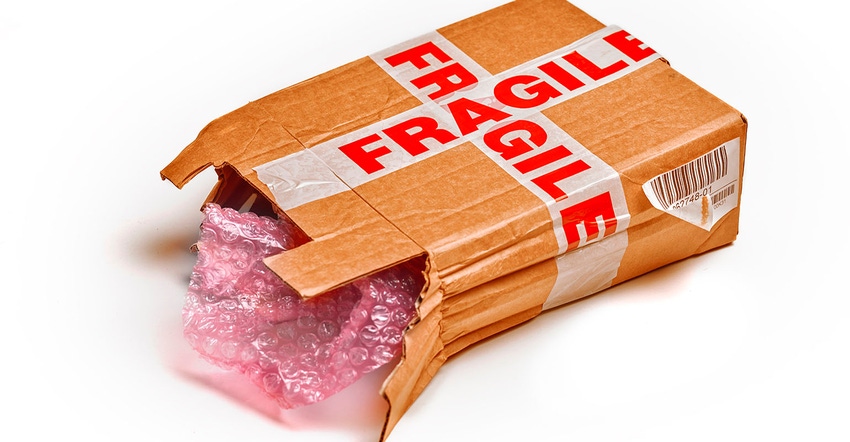Plastics Will Maintain Dominance as Protective Packaging Material of Choice, Study Says
Plastics account for 71% of global protective packaging, a market that is forecast to grow 4% annually through 2027.
May 9, 2023

Plastics will continue by far to be the leading protective packaging material, accounting for 71% of the $33.2-billion global protective packaging industry, according to a recent study by the Freedonia Group, a division of MarketResearch.com. Global protective packaging demand is projected to advance 4.0% per year through 2027 to reach $40.4 billion.
The Global Protective Packaging study said the fastest growing market for protective packaging will be supported by the expanding use of protective mailers, air pillows, and other flexible products in ecommerce order fulfillment. Also contributing to growth is increasing ecommerce shipment of delicate and fragile items, such as electronics, which require greater protection to avoid damage during transit. These materials include molded foams to keep items in place, surface protection films to prevent scratches, and rolled foams for added cushioning.
Modest growth projected for paper
Paper will see moderate growth as sustainability trends — including bans of EPS foam products – will encourage substitution of plastic with paper. Paper fill is seeing more use in e-commerce applications for shipping less-delicate items — such as books and clothing — because of ongoing efforts of major e-commerce vendors to address consumer concerns about packaging sustainability. However, in certain manufacturing applications, a lack of suitable alternatives to plastic will support demand for foams, such as molded EPS.
Molded fiber demand will experience robust growth, with increased use in nondurable goods packaging. Molded fiber is replacing expanded polystyrene in some manufacturing applications as a result of its more environmentally friendly profile in terms of recyclability and degradability.
Sustainability trends also will drive fast growth for biodegradable and compostable materials, such as cornstarch, hemp, soy, and mushrooms. However, the high cost and inferior performance of these bio-based materials will limit their use save in some niche applications.
Historical data provides context
The study presents historical demand data in five-year increments — 2012, 2017, and 2022 — and forecasts — 2022 and 2027 — by product (flexible protective packaging, foam protective packaging, rigid protective packaging); market (durable goods, nondurable goods, e-commerce, retail, and other markets); and region (North America, Central and South America, Western Europe, Eastern Europe, Asia/Pacific, Africa/Mideast).
The study also evaluates company market share and competitive analyses on several industry competitors, including Abriso Jiffy, Cascades, Crown Holdings, DS Smith, Mondi, Packaging Corporation of America, and WestRock.
Ecommerce drives use of flexible protective packaging
Global product demand will be driven by double-digit growth in ecommerce sales, in addition to rising production of durable goods and protective packaging–intensive nondurable goods, such as chemicals and pharmaceuticals, and the food and beverage sector.
Ecommerce has been the fastest growing market for protective packaging over the past decade, as online purchases continue to make up a larger share of retail sales, especially in the United States and China. In addition, ecommerce is rapidly rising in lower income countries as internet access and smartphone penetration grows.
Flexible protective packaging will continue to benefit the most from ecommerce expansion, the study said. A focus on right-sizing and source reduction by online retailers will drive demand for protective mailers. Also, the widespread use of corrugated boxes for ecommerce shipping will support demand for protective packaging that is often used in conjunction with boxes, such as bubble wrap, air pillows, and paper fill.
Impact of sustainability
Although sustainability concerns — such as the use of non-recyclable plastics and the carbon footprint of packaging production — have a larger impact on primary packaging, they will also affect the future growth and product mix in the protective packaging market. These effects will have a relatively larger impact on foam protective packaging, the study said. For example, government regulations limiting or banning the use of certain plastics and manufacturer pledges to reduce plastic use have prompted protective packaging suppliers to offer what are perceived to be more sustainable options, such as paper-based fill and insulating products or starch-based foam products, as replacements for expanded polystyrene.
Although plastic protective packaging, especially foam protective packaging, will continue to be a focus of environmental concern, plastic will continue to be used for protective packaging because of its advantageous properties, including crush and moisture resistance that can prevent leakage during transportation.
Demand surpassed output during last decade
The market for protective packaging products is primarily influenced by trends in manufacturing output and ecommerce sales, according to the study.
Between 2010 and 2020, protective packaging demand grew faster than manufacturing output because of increased awareness of protective packaging’s ability to reduce the rate of returns of damaged goods and the ongoing shift to value-added protective materials with superior performance, according to Freedonia.
The main driver of the protective packaging market in recent years has been the rapidly rising penetration of ecommerce into retail sales. The rise of ecommerce has increased the number of packages requiring protection. Products sold through traditional retail channels often are shipped in bulk rather than in individual parcels.
About the Author(s)
You May Also Like




